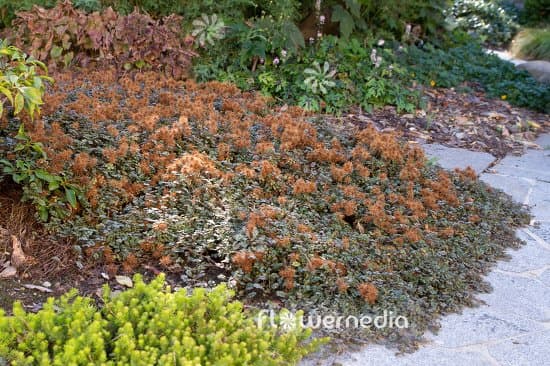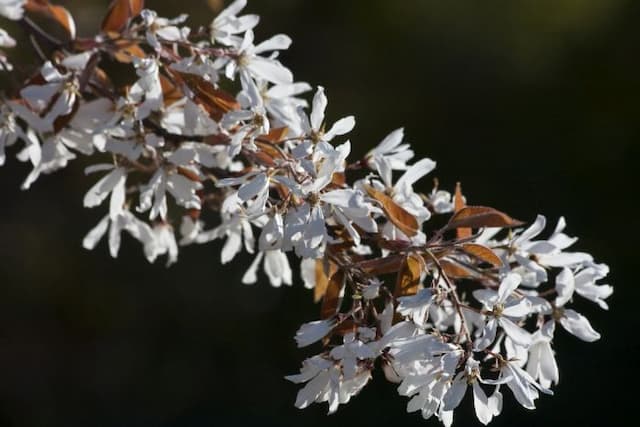Higan cherry Prunus × subhirtella

ABOUT
The plant known commonly as the Higan cherry is a visually appealing ornamental tree adorned with a plethora of delicate flowers. It boasts an elegant branching structure that during its blooming season becomes smothered in blossoms. These flowers range in color from soft pinks to white, depending on the particular variety. Each blossom consists of multiple small petals that form a round and slightly cupped shape, exuding a subtle and pleasing fragrance that is especially potent during the early spring, when the tree typically flowers. The leaves of the Higan cherry emerge after the flowering period, showcasing a fresh, green color that adds to the tree's beauty. These leaves are elliptical with finely serrated edges, and as the seasons progress, they transition into appealing shades of yellow and orange before eventually falling off as cooler temperatures set in. The bark of the tree is another point of visual interest. It has a smooth texture when the tree is young, but as it matures, the bark becomes furrowed, providing an intricate, rough texture and lending additional character to the overall appearance of the plant. The branches spread outward and upward, creating an inviting canopy that is often used for ornamental purposes in landscapes, parks, and gardens.
About this plant
 Names
NamesFamily
Rosaceae
Synonyms
Higan Cherry, Spring Cherry, Winter Flowering Cherry, Rosebud Cherry
Common names
Cerasus subhirtella, Prunus pendula, Prunus itosakura, Prunus itosakura var. ascendens, Prunus subhirtella var. ascendens, Prunus subhirtella var. pendula.
 Toxicity
ToxicityTo humans
The plant commonly known as the ornamental cherry or winter flowering cherry can be toxic to humans if ingested. The primary toxic components are cyanogenic glycosides, which are present in the leaves, twigs, bark, and seeds of the plant. When these plant parts are broken down during digestion, they can release hydrogen cyanide, which is a potent poison. Symptoms of poisoning can include headache, dizziness, confusion, vomiting, difficulty breathing, and in extreme cases, seizures, coma, or even death due to respiratory failure. It is generally uncommon for humans to consume enough of the plant to cause severe poisoning, but caution should still be taken to avoid ingesting any parts of the plant.
To pets
The ornamental cherry or winter flowering cherry poses the same risks to pets as to humans, as the toxic compounds, namely cyanogenic glycosides, are also harmful to animals. If pets ingest parts of this plant, they can experience symptoms similar to those in humans, including vomiting, diarrhea, abdominal pain, weakness, and in severe cases, respiratory failure, seizures, and potentially death. It is particularly important to prevent pets from chewing on the twigs, leaves, bark, or pits of the fruit, as these contain the highest concentrations of the toxic compounds. Owners should seek veterinary attention if they suspect their pet has ingested any part of the ornamental cherry plant.
 Characteristics
CharacteristicsLife cycle
Perennials
Foliage type
Deciduous
Color of leaves
Green
Flower color
Pink
Height
15-25 feet (4.6-7.6 meters)
Spread
15-25 feet (4.6-7.6 meters)
Plant type
Tree
Hardiness zones
5
Native area
Japan
Benefits
 General Benefits
General Benefits- Aesthetic Appeal: The Prunus × subhirtella, commonly known as the Higan cherry, adds visual interest to landscapes with its delicate pink or white blossoms.
- Seasonal Interest: The Higan cherry provides spring blossoms and often features attractive fall foliage, offering multiple seasons of interest.
- Wildlife Habitat: Bees and other pollinators are attracted to Higan cherry blossoms, providing food resources and promoting biodiversity.
- Shade Provision: As a medium-sized tree, the Higan cherry can offer shade for smaller plants, as well as a cooling effect in gardens and parks.
- Cultural Significance: Cherry blossoms have cultural importance in many societies, often symbolizing the fleeting nature of life and are celebrated in various festivals.
- Urban Tolerance: The Higan cherry can tolerate urban conditions like pollution and confined soil spaces, making it suitable for cityscapes and street plantings.
 Medical Properties
Medical PropertiesThis plant is not used for medical purposes.
 Air-purifying Qualities
Air-purifying QualitiesThis plant is not specifically known for air purifying qualities.
 Other Uses
Other Uses- Prunus × subhirtella, commonly known as Higan Cherry, can be used in bonsai cultivation, providing an ornamental and miniature representation of full-sized cherry trees.
- The wood of Higan Cherry is occasionally used in woodworking projects for creating decorative items, due to its fine grain and potential for a smooth finish.
- The blossoms of Higan Cherry may be used to create natural pink dyes for fabrics, offering a subtle hue derived from the petals.
- Higan Cherry branches can be used in floral arrangements and ikebana, the Japanese art of flower arranging, because of their visually appealing blossoms and structure.
- During spring, Higan Cherry flowers are sometimes incorporated into seasonal festivals and celebrations in Japan as a symbol of renewal and life.
- Dried Higan Cherry petals are occasionally used in craft projects, such as handmade paper or potpourri, to add fragrance and decoration.
- Leaves of the Higan Cherry may be used in creating leaf prints or nature-inspired art projects, especially in educational settings.
- The tree itself is planted as a living memorial or commemorative tree in parks and gardens, growing as a symbol of remembrance or honor.
- Photographers and artists often use Higan Cherry trees as a subject or backdrop for spring-themed photographs and paintings due to their picturesque blossoms.
- In certain regions, Higan Cherry trees can be cultivated to provide shade in smaller gardens where their modest size doesn't overwhelm the landscape.
Interesting Facts
 Feng Shui
Feng ShuiThe plant Prunus × subhirtella, commonly known as the winter flowering cherry or Higan cherry, can be utilized in Feng Shui by planting it in the garden to enhance positive chi, especially during its blooming season when it symbolizes new beginnings and renewal. Its graceful form and delicate pink blossoms can help to soften sharp angles or enhance the wood element in your garden's Bagua area, promoting balance and harmony.
 Zodiac Sign Compitability
Zodiac Sign CompitabilityThe winter flowering cherry is not used in astrology practice.
 Plant Symbolism
Plant Symbolism- Delicate beauty: Prunus × subhirtella, or the Higan cherry, blooms with delicate pink or white blossoms, symbolizing fine and subtle beauty.
- Impermanence of life: The Higan cherry's brief blooming period is often associated with the transient nature of life, echoing the Japanese cultural concept of "mono no aware" which is an awareness of the impermanence of things.
- Spring and renewal: With its blossoming typically coinciding with the onset of spring, the Higan cherry embodies the principles of rebirth and new beginnings.
- Educational achievements: In Japan, the timing of the Higan cherry blossoms often coincides with the start of the school year and graduation season, making it a symbol for educational accomplishments.
 Water
WaterThe Winter Cherry Blossom or Higan Cherry should be watered deeply and slowly to ensure the water reaches the root zone, approximately once a week during dry spells, with around 1 to 1.5 gallons per session for young trees, and increasing to 2 to 3 gallons as the tree matures. During the growing season, check the soil moisture regularly, as overwatering can lead to root rot. In winter, reduce the frequency to only when the soil is dry and not frozen.
 Light
LightWinter Cherry Blossom thrives best in full sunlight, with at least 6 hours of direct sunlight per day. Planting in a spot that receives morning sunlight and partial afternoon shade can help protect the tree from the intense heat of late afternoons during the hottest part of the summer.
 Temperature
TemperatureWinter Cherry Blossoms are adaptable to a wide range of temperatures, tolerant of winter lows down to around -20 degrees Fahrenheit, but they grow best when spring and summer temperatures average between 60 and 75 degrees Fahrenheit. Extreme heat above 100 degrees Fahrenheit may harm the plant.
 Pruning
PruningPrune the Winter Cherry Blossom to maintain its shape, remove any dead or diseased branches, and encourage healthy growth. The best time to prune is in late winter or early spring before the new growth begins. Pruning should be done annually or as needed.
 Cleaning
CleaningAs needed
 Soil
SoilHigan cherry requires well-draining soil with a mix of loam, compost, and sharp sand to ensure proper root health. A slightly acidic to neutral pH, ranging from 6.0 to 7.5, is ideal for this ornamental cherry tree.
 Repotting
RepottingHigan cherries, being large trees, are not typically repotted. Instead, young trees should be transplanted to their permanent outdoor location. Mature Higan cherry trees do not require repotting.
 Humidity & Misting
Humidity & MistingHigan cherry thrives in average outdoor humidity levels. While it can tolerate a range of conditions, excessively dry air might stress the tree, so average ambient moisture is satisfactory.
 Suitable locations
Suitable locationsIndoor
Not suited for indoor growth; requires outdoor environment.
Outdoor
Plant in full sun, well-draining soil, and provide water and mulch.
Hardiness zone
5-8 USDA
 Life cycle
Life cyclePrunus × subhirtella, commonly known as the Higan cherry or spring cherry, begins its life cycle with seed germination in the spring, after experiencing a period of cold stratification which breaks the seed's dormancy. The seedling stage follows, involving initial root formation and shoot development. As the plant grows into a sapling, it starts developing its characteristic branching structure and foliage. The Higan cherry reaches maturity within several years, progressing to the flowering stage where pink to white blossoms emerge in early spring before the foliage, an important period for pollination by insects. Following successful pollination, the tree produces small fruit which contains seeds to complete the reproductive cycle. Over years, the mature tree goes through cycles of growth, flowering, and fruiting, with proper care and conditions allowing it to live and thrive for many decades.
 Propogation
PropogationPropogation time
Spring
Propogation: The most popular method of propagating Prunus × subhirtella, commonly known as the Higan cherry, is through softwood cuttings. This is usually done in late spring or early summer when new growth is soft and flexible. Cuttings should be about 4 to 6 inches (10 to 15 centimeters) long and taken from healthy branches. The leaves on the lower half of the cutting are removed, and the cut end is dipped in a rooting hormone to encourage root development. The prepared cutting is then inserted into a pot filled with a well-draining potting mix. It's important to maintain high humidity around the cutting, which can be achieved by covering the pot with a plastic bag or placing it in a propagator. Rooting typically occurs after several weeks, and once established, the new plants are gradually acclimated to outside conditions before planting in their permanent locations.

![Tree amelanchier [Tradition]](/_next/image?url=https%3A%2F%2Fplants-admin.emdemapps.com%2Fimages%2Fplants%2F%2Fimages%2F604b56afa99a2.png&w=640&q=75)




![Strawberry [Just Add Cream]](/_next/image?url=https%3A%2F%2Fplants-admin.emdemapps.com%2Fimages%2Fplants%2F%2Fimages%2F604b5f8e7d168.png&w=640&q=75)


